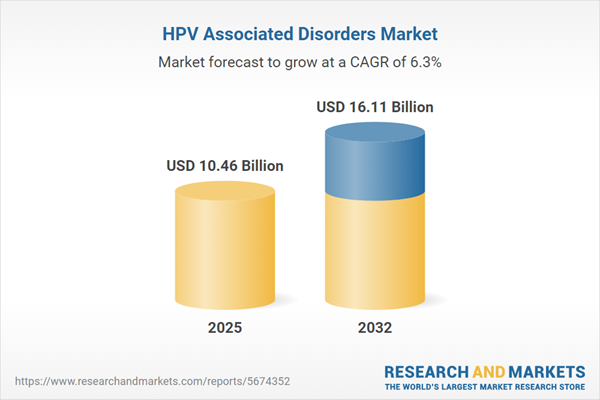Speak directly to the analyst to clarify any post sales queries you may have.
The HPV Associated Disorders Market is evolving rapidly, shaped by innovative diagnostics and progress in preventive care. Senior decision-makers face strategic imperatives to navigate shifting regulations, capitalize on advancing technologies, and optimize operational models to address complex global healthcare needs.
Market Snapshot: HPV Associated Disorders Market Growth and Opportunity
Market expansion in the HPV Associated Disorders Market is being fueled by broader adoption of advanced screening techniques and a surge in investment in molecular diagnostic technology. This momentum is heightened by increased focus on immunization initiatives across healthcare stakeholders. Enterprises are streamlining service portfolios, prioritizing regulatory alignment, and reformulating operational strategies in response to evolving payer expectations. Global and localized partnerships are facilitating the rollout of scalable, region-specific solutions that are both compliant and efficient. Additionally, the landscape is characterized by improved reimbursement systems and initiatives focused on long-term value, reinforcing market visibility and encouraging cohesive stakeholder engagement as industry requirements shift.
Scope & Segmentation
Designed for senior executives, this analysis offers a strategic breakdown of the HPV Associated Disorders Market, highlighting actionable opportunities and key market divisions.
- Product: Reviews a spectrum of molecular diagnostic options, including both HPV DNA testing innovations such as Hybrid Capture and PCR. Coverage extends to liquid-based and conventional Pap tests, therapeutic approaches like chemotherapy and radiotherapy, and procedures such as surgical intervention, cryotherapy, laser ablation, and topical treatments. Vaccine insights span bivalent, quadrivalent, and nonavalent segments, focusing on prevention pathways and portfolio growth.
- Indication: Covers the continuum from prevention, screening, and treatment, encouraging integrated population health tactics. Emphasizes adoption of digital health tools that optimize patient identification, timely intervention, and continuous care management strategies.
- End User: Analyzes the contribution of ambulatory surgery centers, specialty clinics, diagnostic laboratories, and a wide spectrum of hospital settings—public and private—to the expansion of screening and treatment services in diverse healthcare environments.
- Distribution Channel: Outlines accessible purchasing options and supply flows, featuring direct procurement paths, hospital and community pharmacy networks, digital platforms, and retail channels, all designed to strengthen healthcare provider access and ensure responsive supply chains.
- Region: Assesses dynamics across the Americas, Europe, Middle East, Africa, and Asia-Pacific, emphasizing factors such as local adoption trends, tailored regulatory frameworks, and distinctive models of healthcare delivery responsive to each market’s requirements.
- Companies: Profiles market-shaping organizations including Merck & Co., Inc., GlaxoSmithKline plc, Roche Diagnostics International AG, Hologic, Inc., QIAGEN N.V., Abbott Laboratories, Becton, Dickinson and Company, Danaher Corporation, Thermo Fisher Scientific Inc., and PerkinElmer, Inc., noting their ongoing influence in driving therapeutic and diagnostic innovation.
Key Takeaways for Decision-Makers
- Innovations in molecular diagnostics and advanced vaccines are shaping prevention policies and supporting earlier, more effective patient management strategies for HPV-associated disorders.
- Emerging healthcare regulations and updates to payer frameworks bring digital health standards to the forefront, requiring agility and comprehensive regulatory adherence from organizations.
- Market participation benefits from adapting engagement strategies to suit distinct regional care infrastructures, given the varied local governance and healthcare models observed across major regions.
- Proactive investment in building resilient supply chains is increasingly crucial, as shifting trade and tariff landscapes impact the sourcing, logistics, and delivery of critical diagnostic and vaccine solutions.
- Cross-sector collaborations—linking diagnostics, immunization, and digital technologies—are driving the creation of connected, value-based care models and enhancing the interoperability of healthcare systems.
- Digital transformation and locally customized approaches are essential for maintaining organizational competitiveness as global and regional market conditions continue to evolve.
Tariff Impact
Ongoing changes in tariff structures are directly influencing procurement costs within diagnostics, vaccine acquisition, and logistics management. Industry leaders are responding by broadening sourcing strategies, extending regional manufacturing footprints, and fortifying supply frameworks. These adaptive measures help maintain consistent compliance with international trade regulations, with a focus on operational cost control and sustained service continuity for healthcare collaborators.
Methodology & Data Sources
This report synthesizes insights from structured interviews with domain experts, critical appraisal of current clinical research, and ongoing monitoring of policy trends across regions. Detailed market benchmarks are applied to ensure relevant, high-priority intelligence for executive decision-making.
Why This Report Matters
- Delivers actionable guidance to senior leaders, empowering proactive management of regulatory, technological, and reimbursement complexities in the HPV Associated Disorders Market.
- Enhances operational planning and risk management, equipping organizations to adapt quickly as market priorities and requirements evolve.
- Supports evidence-based, cross-functional decision-making, strengthening outcome predictability as business models and standards transform.
Conclusion
Grounded in strategic insight, this report provides senior decision-makers with the practical resources required to optimize organizational strategies and remain agile in the dynamic HPV Associated Disorders Market.
Additional Product Information:
- Purchase of this report includes 1 year online access with quarterly updates.
- This report can be updated on request. Please contact our Customer Experience team using the Ask a Question widget on our website.
Table of Contents
3. Executive Summary
4. Market Overview
7. Cumulative Impact of Artificial Intelligence 2025
Companies Mentioned
The companies profiled in this HPV Associated Disorders market report include:- Merck & Co., Inc.
- GlaxoSmithKline plc
- Roche Diagnostics International AG
- Hologic, Inc.
- QIAGEN N.V.
- Abbott Laboratories
- Becton, Dickinson and Company
- Danaher Corporation
- Thermo Fisher Scientific Inc.
- PerkinElmer, Inc.
Table Information
| Report Attribute | Details |
|---|---|
| No. of Pages | 186 |
| Published | October 2025 |
| Forecast Period | 2025 - 2032 |
| Estimated Market Value ( USD | $ 10.46 Billion |
| Forecasted Market Value ( USD | $ 16.11 Billion |
| Compound Annual Growth Rate | 6.3% |
| Regions Covered | Global |
| No. of Companies Mentioned | 11 |









